We may never understand the full story behind the snap, crackle, and pop, because finding money for experiments on cereal noises isn’t easy.”
– Corey Binns, Live Science
Buenos Aires – I realized I forgot to post up notes from the class nearly two weeks ago, along with last week’s which I knew I was behind on. So, it’s catch-up time – deadlines for paying jobs do tend to put one behind on their “fun writing”, i.e., the blog. Class number five was another texture class, in particular the texture of crunch. It was a class with some odd results, since the vast majority of what was being demonstrated was there specifically for its crunchiness, meant to be used in combination with other things down the line, but as a presentation, leaving us a bit… dry.
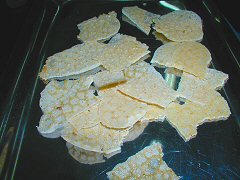
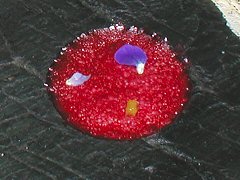
On the surface, these probably seem to be completely different, and in some ways they are. But, in one way in particular, they’re much the same – they’re both crispy, crunchy versions of foodstuffs that are normally soft and squishy. On the left, arlette iberica – the former a term I’ve never encountered, nor was I able to find “arlette” in any of my food references. I found a scattered few on the internet, all referring to a wafer thin sort of garnish, but I’m not sure exactly how one would define it. This, regardless, is a wafer of pig’s feet – the feet are soaked in ice water for a day, then cooked, the meat removed from the bone, then mixed with the fat from prosciutto, some water, and flour, and then cooked as paper thin sheets. You end up with a product that tastes pretty much like a classic chicharrón, though taking a huge amount more work, even if the end result is, perhaps, prettier. On the right, a crunchy wafer of raspberries, made from literally nothing more than pureed frozen raspberries with just enough water to smooth out the puree if needed. The puree is spooned out onto a silpat and cooked in a low heat oven very slowly until it dries out – passing first through the “fruit leather” stage, and eventually drying out more or less completely.
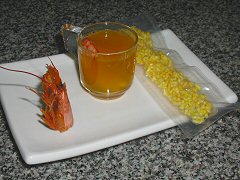 This was, in a strange way, a kind of interesting approach to a deconstructed paella. I’ll say up front that I’d much rather have a big steaming platter of freshly made paella in front of me, but nontheless, I could see that this had some potential for other possibilities. It’s very simply rice that’s been cooked in a saffron broth, then thoroughly drained, spread out on parchment paper on a sheet pan and dried out in an oven for six hours at about 175°F. Then, when completely dry, and it really has to be completely dry to work, it’s dropped into a deep fryer, or a pot of oil at high temperature, where it instantly inflates. For this presentation it was then sealed in a vacuum pack to be served alongside a shrimp broth with a couple of shrimp in it and the head on the side… and no, when you open the package and let the inflated rice drop into the soup, it doesn’t make a snap, crackle, pop sound – I’m guessing, based on the bit of science I could find about how rice krispies work, that it’s because the broth is hot rather than cold, and so the inflated rice cell walls don’t shatter the same way.
This was, in a strange way, a kind of interesting approach to a deconstructed paella. I’ll say up front that I’d much rather have a big steaming platter of freshly made paella in front of me, but nontheless, I could see that this had some potential for other possibilities. It’s very simply rice that’s been cooked in a saffron broth, then thoroughly drained, spread out on parchment paper on a sheet pan and dried out in an oven for six hours at about 175°F. Then, when completely dry, and it really has to be completely dry to work, it’s dropped into a deep fryer, or a pot of oil at high temperature, where it instantly inflates. For this presentation it was then sealed in a vacuum pack to be served alongside a shrimp broth with a couple of shrimp in it and the head on the side… and no, when you open the package and let the inflated rice drop into the soup, it doesn’t make a snap, crackle, pop sound – I’m guessing, based on the bit of science I could find about how rice krispies work, that it’s because the broth is hot rather than cold, and so the inflated rice cell walls don’t shatter the same way.
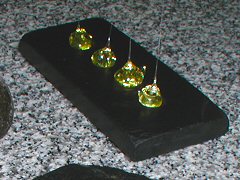
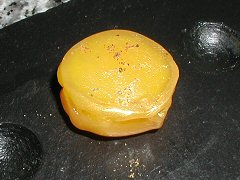
These are two also related items – a crunchy caramel outside filled with something liquid inside. On the left, teardrops of flavored oil, in this case sesame oil. The basic procedure, and unfortunately I wasn’t able to get any good photos of it, is that you liquify some isomalt, a type of sugar, and bring it to the stage where it’s more or less a light caramel, about 245-250°F. Have your flavored oil in a small spoon… Using a short piece of hard plastic tubing, maybe an inch or a little more in diameter, you dip it in the caramel, and then over a half-round mold, you drop the oil from the spoon into the center – essentially it’s like you’d blow bubbles through a bubble-making ring, only you’re using oil rather than air to form the bubble. You immediately sort of grasp the trail of caramel that comes off the ring to lightly pull it, which seals the bubble of caramel and makes a sort of teardrop shape. It’s clearly something that takes a lot of practice, and, of course, the liquid that goes into the center has to be something that won’t dissolve the isomalt caramel – so nothing water based. On the right, different use of a caramel – in this case a mix of isomalt, glucose, and standard icing fondant (1:1:2 ratio), spread paper thin to harden into little panes of caramel glass, and then, one is place atop a quail’s egg yolk, and remelted using a heat gun, the same kind one would use to dry paint or other sorts of things, you could probably even use a hair dryer on a high setting. When the sheet of caramel has molded itself to the top of the yolk, you let it harden a moment, and then carefully flip it over, not breaking the yolk, and repeat on that side – you end up with an egg yolk encased in caramel – a rather cute, if labor intensive garnish.
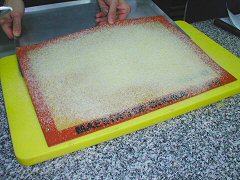
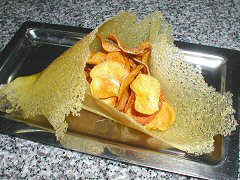
This is just crunchy all around. In the center, very simply, sweet potato chips. Deep fried, nothing special about their preparation, sweet potato chips, lightly salted. Around it is the “technique” we were out to learn – take some of those chips, prior to salting them, let them cool, and then process them into a very fine powder. Melt isomalt and glucose (1:3 ratio) and bring to about 320°F. Add some of the powdered sweet potato to it, it looked like roughly equal volume, and then let that cool. Process that into a fine powder and using a coarse strainer, spread a thin layer of the powder over a silpat. Throw it in the oven to re-melt the caramel, which forms a sort of tissue thin lacey cookie which can be molded into various shapes for presentation while it’s still warm. A lot of work to get something like that out of a sweet potato, but there’s probably no other way to do it.
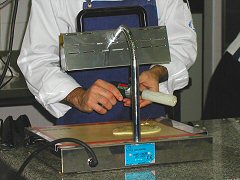
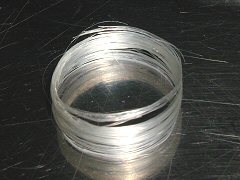
The last thing we looked at was making an olive oil thread – I’m going to have to admit, the recipe went by too fast for me, and it wasn’t in the written materials that we were given – but as best I was able to glean from talking to some of the other students, it was first a mix of 100gm isomalt, 25gm glucose, and 1.5gm Sucro-ester, brought to about 320°F; meanwhile 30gm olive oil and 1.5gm of a monoglycerine are heated in a microwave, then the two are beaten together, the oil mixture being slowly drizzled into the other while rapidly beating. After that, the whole thing is spread under a strong heat lamp to keep it more or less molten, and then a high speed drill with a plastic rod on it is used to pull a very fine thread out of the mixture. It was clearly a lot of work, and took a huge amount of effort just to get one coil of this thread, as it kept breaking during the spinning process.
Coming up on the next classroom report, how to use your vacuum…